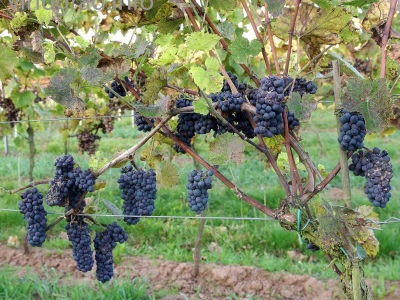
- Authors: France
- Appointment: technical
- Berry color: purple
- Ripening period: early
- Frost resistance, ° C: -27
- Name synonyms: Millau, Kuhlman 194.2
- Flower type: bisexual
- Damage by wasps: high degree
- Density of the bunch: dense
- Skin: thin
The Leon Millau grape (synonyms Millau, Culman 194.2) is an early ripening hybrid bred in France. It has a technical purpose - for the production of wine, sometimes it is used for fresh consumption.
Breeding history
It appeared in 1911 thanks to E. Kuhlmann in Alsace. It arose when the varieties Riparia, Rupestris and Goldrisling were crossed (according to other sources, Oberlin 595 and Goldrisling).
Description
The Leon Millau grape is hybrid and ripens early. In appearance, it is similar to the Marshal Foch variety, only it is higher, it grows up to 1.6 m, and the yield is greater. The cultivar's exceptional taste and chocolate notes attract wasps that need to be dealt with.
Ripening period
The Leon Millau grape belongs to the early maturing varieties. However, in the northern regions, this process occurs in September. Large-scale collection begins immediately after the ripeness of the bunches.
Bunches
The brushes are in the shape of a cylinder, densely formed, in size slightly less than average. Their weight varies from 130 to 150 g.
Berries
The berries are dense, oval, elongated, size 12 by 16 mm. The color is dark purple, there is a pale bloom. The approximate weight of one fruit is up to 6 g. The pulp is sweet, with a chocolate aroma and intense juice. The rind is thin.
Taste
Leon Millau is a unique variety, in addition to the distinctive external characteristics of a fresh product, you can emphasize the pleasant taste of wine and juice. Winemakers use grapes to increase the color of the blend and the content of sucrose. In its pure form, wine products from this variety look velvety, with an excellent consistency and a delicious smell.
Yield
High-yielding. Up to 10 kg of berries can be harvested from one m2.


Growing features
Growing the Leon Millau variety involves following a number of simple actions: timely watering, loosening the soil, pruning dry branches, top dressing according to the seasons, treatment from pests and storage features. The main thing is to replace the outdated vine with new material.
Landing
It is important for the grapes to choose the right planting site. Good natural light is taken into account, blowing warm air. And also a fertile soil is required - light, with admixtures of mineral fertilizers.
When a seedling grows inside a comfortable environment (container), it should be removed after preliminary soaking in water for about 30 minutes. In advance (14 days), it is necessary to dig a depression for future planting, triangular in shape, where its side will be 40 cm.Put humus inside the hole (at the bottom) (10 cm is enough), then fill it with a substrate until the middle.
At the time of planting the prepared vine, it is advisable to leave it for an hour in a solution that stimulates growth. Place the seedling in the center of the hole, carefully sprinkling it with earth. Undistributed roots must be placed at the top of the embankment.

Pollination
Thanks to the bisexual type of flower, pollination occurs independently. This is especially useful as it increases fruiting and reduces the likelihood of a low yield.
Pruning
Pruning is desirable in February. It is necessary to remove dry, weak, bruised and painful branches.
If necessary, the process can be repeated in the autumn, no later than 30 days before the first frost. The pruned area is treated with garden pitch, and the pruned branches should be disposed of through burning, necessarily if there are residual signs of parasites or disease.

Watering
Moistening the ground near the bush should be done for the first 120 days immediately after planting. In drought, watering is necessary 1-3 times a week, depending on the drying of the soil.
The bush is growing, watering is no longer required of the same intensity, but the amount of water is increased in one approach. For the first year of life, 10 liters / time is enough for this grape variety, and from a year - 20-30 liters.


Frost resistance and the need for shelter
Leon Millau grapes can withstand up to -27 ° C. Mature shrubs do not need shelter, which is not the case with weak, newly planted vines. Within a year after planting, it should be covered: roots - sawdust, covering material, eggshell (also suitable as fertilizer, retains heat), shoots / branches - spunbond.

Diseases and pests
Leon Millau grapes are not afraid of fungal diseases and are moderately resistant to root and leaf phylloxera. Of the obvious pests, wasps can be identified, but with timely control of them, the characteristics of the grapes and he himself do not deteriorate.

If a grape is exposed to any disease or insect, this always affects its appearance.
Storage
Depends on the finished product:
berries - in the refrigerator for no more than 4-7 days;
wine - in wooden barrels or dark glass bottles.
Grapes Leon Millau is versatile and unpretentious: it is enough to water and prune branches in a timely manner. Grown for winemaking. The long shelf life of the berries of exceptional taste allows the production of wines of the desired velvety structure with a sweet taste and hints of chocolate.











































































